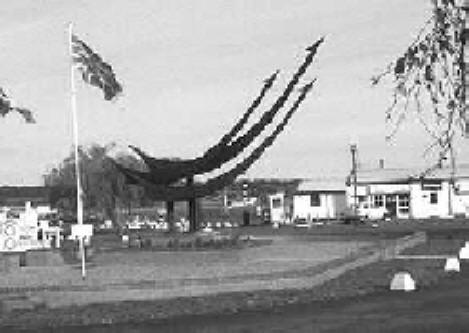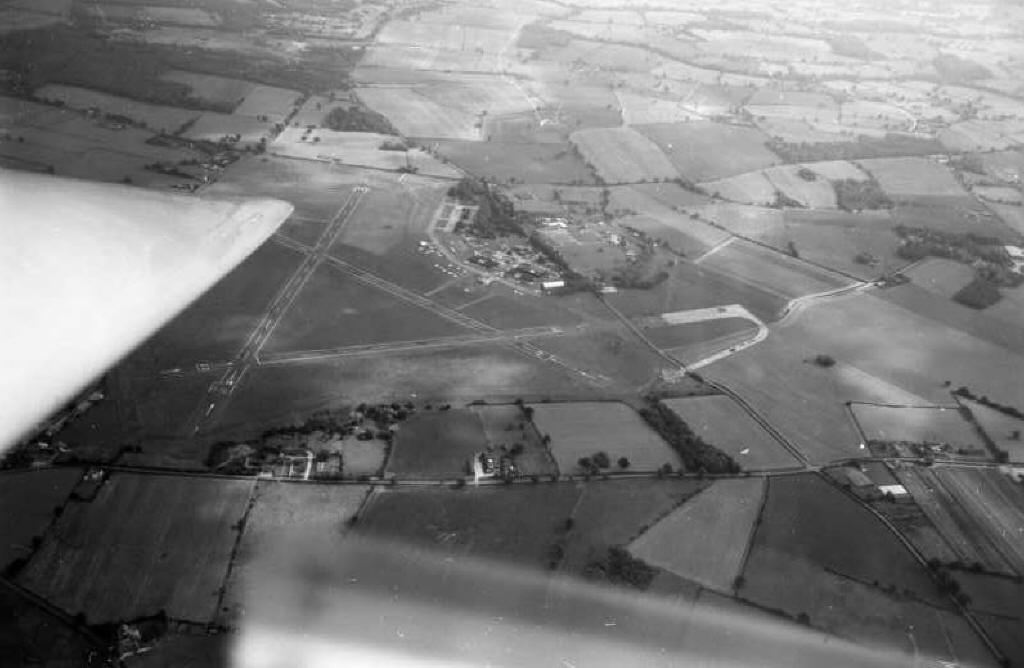Halfpenny Green Airfield.

The training of new aircrew during the Second World War was a massive programme. From the start of the war the Air Ministry decided on a policy that the majority of the airfields involved should be located in the Midland Counties, well away from the more operational air space above the eastern side of England.
Staffordshire was one of the counties chosen to have training airfields built upon it soil, and a site a few miles west of Birmingham was deemed suitable for development into a flying training station.
Work on constructing Bobbington airfield commenced in early 1940, and evidence of this early start is the fact that all the seven Bellman steel hangars, plus the many other technical buildings, were all grouped together at the south side of the landing area. The many messes and domestic accommodation were also located close by, and not dispersed miles away as was the case later on.
Due to the poor drainage of the area it was decided to lay three concrete runways and perimeter track, around which were to be erected an extra 16 Blister type hangars. By the time these facilities were completed it was June 1941 before the station was ready to be used for flying.
R.A.F Station Bobbington was taken over by No.51 Group, Flying Training Command on the 17th of February 1941, and although No.3 Air Observer Navigation School formed here at that time, no flying took place until improvements to the airfield proper had taken place.
By April training had commenced when a total of 35 Blackburn Botha aircraft had arrived for use as flying classrooms for the training of navigators, a trade that was in much demand by bomber squadrons then being formed, or to replace those lost on operations.
The Botha was a very inefficient rejected torpedo bomber that was now relegated to this training role. It was not at all liked by pilots or students, and there was a sigh of relief when these were replaced by faithful and reliable Avro Ansons in the following July.

Strange as it may seem, all the 70 or so Ansons in use here were serviced by the civilian contractor, Marshalls of Cambridge, but all the instructors and admin staff were of course RAF personnel.
In October 1941 the title of the establishment changed to No.3 Air Observer School, and later still in April 1942 to No.3 (O) Advanced Flying Unit. By that time the navigators were receiving their basic training in Canada so this unit became one of ten in existence in the U.K which provided continuation training for navigators arriving back in this country.
Not only were the students British subjects, but also Free French, Canadian, Australians and New Zealanders, as all these nations then had operational squadrons within the RAF, chiefly in Bomber Command.
It was around this time that the station’s name was changed to Halfpenny Green to stop any confusion with a new airfield near London that was called Bovingdon.
A terrific number of flying hours were achieved each month as the syllabus included long distance navigation flights way out over the Irish Sea and beyond. Flying took place both by night and by day, and not without accident because many aircraft were lost when training pressed on in some pretty poor weather.
From December 1942 to February 1943, sections of the School of Flying Control were also in residence. They operated around twelve Avro Ansons here whilst their own base at Watchfield was having runway lighting fitted.
Another small unit to be based here from April 1944 to the end of November 1945 was No.1545 Beam Approach Training Flight with a handful of Oxford aircraft. These were used for giving the resident staff pilots, and also those at other local airfields, experience at using the semi blind approach radio beam system known as S.B.A, the main runway at this airfield having been fitted with the necessary radio beam transmitters.
The training of navigators even continued for a short while after the war ended but on a very reduced scale, until on the 11th of November all training ceased, after which the aircraft were flown out to storage depots and No.3 (O) A.F.U disbanded on the 1st December 1945.
Maintenance Command were always looking for disused airfields that possessed more than the average number of hangars in order that they could stuff them full of war surplus equipment, in this instance aircraft components. This airfield then became a sub site of No.25 M.U. Hartlebury, and it was late 1956 before all stocks had been disposed of.

As a result of the Korean War the R.A.F started to expand and this led to more training airfields being required. Halfpenny Green became involved, and on the 15 May 1952 No.2 Air Signallers School formed here with a compliment of Avro Anson Mk19/21 plus a lesser number of Prentice aircraft. This school was engaged in the training of the new breed of wireless/radar operators, primarily for Bomber Command, who were still using them in Lincoln bombers and B29 Washingtons.
The above era was relatively short, and with the Korean War at an end the demand for Air Signallers was reduced, consequentially this No.6 A.S.S closed on the 13th September 1953. This left only the storage commitment of No. 25 M.U who continued to use the hangars until they too closed on the 15th November 1956.
Although still Air Ministry property for the remainder of the decade, the airfield site was sold off in 1960, and in March 1961 it became a civilian aerodrome. From small beginnings, aviation activity gradually built up with both a flying club and flying school aircraft using the facilities.
During the 1970s air races took place, and at one of these in 1972, Prince William was killed when his aircraft crashed on take off. Click here for for information
 Designed and created by Chipmonk Computing
Designed and created by Chipmonk Computing